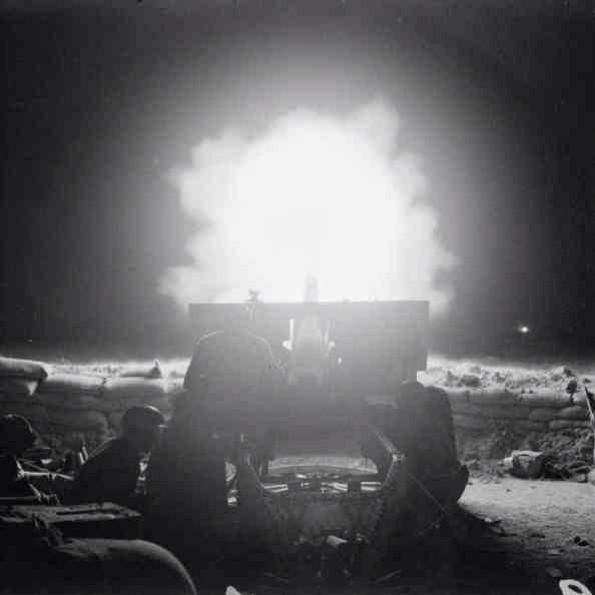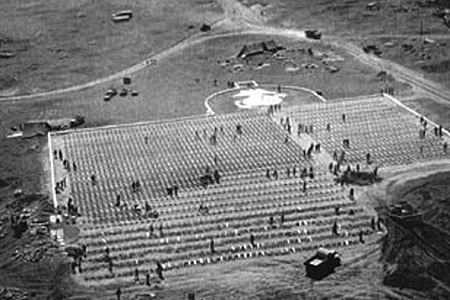November 16, 1945 : X+1 – off Kyushu
…This morning the weather brought low clouds with a chance of rain and heavy kamikaze showers. Before that a wave of suicide boats made out from the many nooks on Koshiki-retto, through a dim pre-dawn haze. The 160th regiment of the 40th infantry division has been working to clear any threats from that island since X-4, together with Navy destroyers circling the jagged shore. Much ordnance has been expended against the rocks there, blasting any suspicious looking crevice which might hide a small ship. But there are a great many crevices and clearly some of the deadly boats survived.
Kamikaze planes were expected at the first bit of bad weather, but the risk from attack boats was supposed to be eliminated. Destroyer picket screens against incoming aircraft are well beyond Koshiki-retto from this invasion fleet. Just one destroyer was patrolling between our big ships and the island, and she was busy this morning just keeping them at bay from her own hull. The USS Charette claims five shinyo sunk, with another probable. That may have been most of them, but we know at least three more got through, because they found the cruiser USS Little Rock and my recent acquaintance the USS Red Oak Victory. The Red Oak was back to her old job of at-sea re-supply of ordnance to Navy ships. The Little Rock did her share of pre-invasion shore bombardment, and was to continue the job of delivering fire support after taking on more deadly packages.
The Red Oak Victory was parallel to the shore, less than two miles off, tethered to the Little Rock. Gunners on the Red Oak may have hit some of the attacking boats, but the Little Rock reports that two of them got close enough to blow big holes in her hull, possibly starting off secondary explosions in the holds, and put her under in a blink. It was all the cruiser could do to cut the transfer lines and get clear of the sinking ship so they wouldn’t smash any swimming survivors. Little Rock’s gunners barely caught a glimpse of a final suicide motorboat gunning past the rolling wreck. The boat closed the last few dozen yards to the Little Rock and its multi-hundred-pound bow charge ripped through the light cruiser’s armor. I have no word on fatalities from below, but one machine gun crew on deck reported injuries from wood splinters and impact from one severed human hand.
The Little Rock is still afloat, after a scary stretch of fire fighting and damage control work. As the news came in, I sat in my corner of the radio room with an angry knot in my stomach at the certain fate of so many of my friends from the hard-working Red Oak Victory. Radio traffic continued its steady professional cadence. Hold picket screen, do not adjust. Oakland to assist. Task two fleet tugs. Notify USS Comfort.
Radio calls picked up urgency as two radar pickets ships saw a swarm of objects at the same time. A loose mass of objects came at cloud level from the direction of Nagasaki . Dozens more stragglers spanned fifty miles behind the main body. It was just at first light , so our radar equipped night fighters were still on station. One at a time they braved the cloud layer to hunt by glowing scope. Flying singly in strict zones to avoid collisions, they would do little to reduce the pack.
Close flying through clouds is no picnic, even for veteran pilots. Our second line of picket ships reported at least one pair of wrecked planes tumbling down out of the clouds, probably after a mid-air collision. Minutes later the outer ring of destroyers in our invasion fleet opened up with radar-directed flak at the approaching mob. Other ships joined in before I heard excited Japanese from one of the radios which had been silent.
I ran outside to look, brushing aside a scolding ensign, who shut the hatch behind me. Scores of Japanese planes dropped down out of the clouds. Two dozen Navy fighters, up and ready from the early radar picket alert, were inbound from the west to meet them. Once the forces merged it would be impossible for ships’ gunners to target Japanese planes without endangering American pilots. This rarely stopped American gunners under kamikaze attack.
One Japanese plane broke out, faster than the others, directly at my ship. I didn’t run or even flinch. Some how I knew she was not meant for me. The Jap plane streaked along low and level, shifting sideways just enough to be difficult to hit. The pilot was cool and experienced. I could see that his plane had no bomb. He did have two U.S. Navy “Hellcats” on his tail. The Japanese plane tore over my ship and I recognized it as one of the newest types, a Shinden, faster and stronger than the famous Reisen “Zero” that gave the world so much trouble through 1942.
Behind the Shinden were the two American fighters. Behind those were three older Japanese Navy planes just coming into view, each with an oversize bomb slung below. Our F6s were almost upon the dodging Shinden, and the lead Hellcat tore into it, throwing .50-caliber slugs through its structure and making the engine smoke. The Jap pilot pulled up into a full 180 degree reversal, adding a half barrel roll near the top, keeping up airspeed along the way. The surprised American fighters started a long level turn to come around and finish their prey. But the lead Japanese pilot had done his job. His three followers stormed ahead free of opposing fighters. They weaved near wave top, daring Navy gunners to shoot so low they could hit other ships. Gunners did fire, from every angle, and shortly the left plane erupted into a shower of debris which scattered over the water. The other two bore on, absorbing minor hits, engines screaming.
Just 300 yards forward and to port of my ship was the transport USS Montrose, also carrying elements of the 5th Marine Division. Like us she was still full, waiting for the division to get orders ashore. With barely a dozen yards to spare, gunners on the Montrose found the right plane in the remaining suicide pair, causing it to break apart, but it was too late. Most of both planes plowed into the side of the lightly armored transport, the bomb from the damaged plane impacting somewhere below the water line. In a dramatic flourish the injured Shinden pilot finished his flaming dive directly into the superstructure of the rapidly listing transport.
The Montrose sank in eight minutes. The Third Battalion of the 28th Marines ceased to exist.











